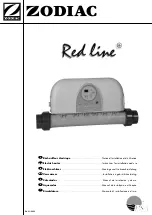
EN
10
Operating manual – oil heater IDE 20 D / IDE 30 D / IDE 50 D / IDE 60 D / IDE 100 D
Maintenance
Activities required before starting maintenance
Warning of electrical voltage
Do not touch the mains plug with wet or damp hands.
•
Switch the device off.
•
Hold onto the mains plug while pulling the power cable out
of the mains socket.
•
Allow the device to cool down completely.
Warning of electrical voltage
Tasks which require the housing to be opened
must only be carried out by authorised specialist
companies or by Trotec.
Cleaning the housing
Clean the housing with a soft, damp and lint-free cloth. Ensure
that no moisture enters the housing. Protect electrical
components from moisture. Do not use any aggressive cleaning
agents such as cleaning sprays, solvents, alcohol-based or
abrasive cleaners to dampen the cloth.
Wipe the housing dry after cleaning.
Filling the tank
The tank cover and the filling level indication of the
IDE 20 D / IDE 30 D are located at the rear of the device, those
of the IDE 50 D / IDE 60 D / IDE 100 D are located on the left
side of the control panel. The images in the description below
show the IDE 100 D by way of example.
ü
Before attempting to fill the tank, wait until the device has
cooled down completely.
ü
Only use fuel suitable for the device (see technical data).
1. Position the device on firm, level and incombustible
ground.
2. Unscrew the fuel tank cap (5).
THERMOS
TAT CONT
ROL
CLOSE
OPEN
5
7
3. Fill the tank. In doing so, observe the filling level
indication (7). Stop filling the tank just before the red
range.
4. Screw the fuel tank cap (5) back onto the tank. Observe
the recesses at the tank opening and the protrusions at the
fuel tank cap. They must be aligned when attaching the
fuel tank cap. Make sure that the fuel tank cap is firmly
attached to avoid leakage.
Draining the tank
25 30
35
40
45
5
10
15
20
1. Provide for a suitable collection container.
2. Move the device to an elevated position.
3. As indicated in the figure use a wrench to open the screw
at the bottom of the tank.
4. Drain the fuel into the collection container.
5. When no more fuel is discharged, seal the drain hole
again.
ð
Ensure the tight fit of the screw and, if required, replace
the seal, for otherwise fuel might leak out
uncontrollably.
6. Dispose of the fuel according to national regulations.
































